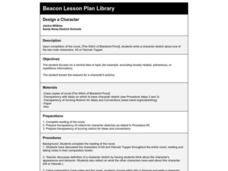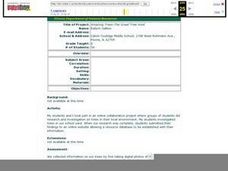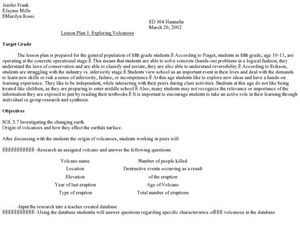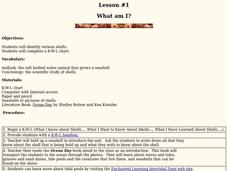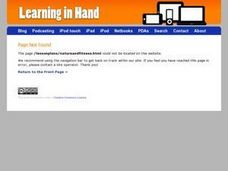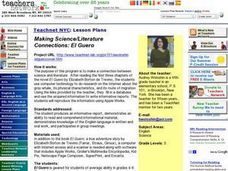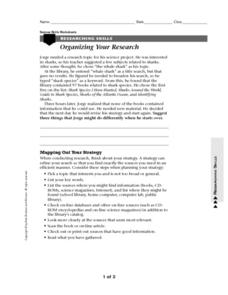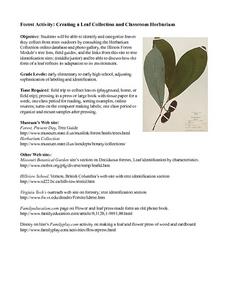Curated OER
Identifying Butterflies Using a Database
Students use the internet and books to develop a database that can be used to identify the common butterflies of Los Angeles. They create a new database called "Butterflies" and enter headings for the required information. Students...
Curated OER
Disasters - Where, When, Why
Fourth graders research natural disasters that have occurred in the US in the 20th Century. They create a computer database of the disasters and write a paragraph with the information.
Curated OER
From Yosemite to Joshua Tree
Fourth graders discover diversity of plant and animal life in California's parks and compare findings to identify what makes park areas unique. Students then publish their discoveries in picture books of their own design.
Curated OER
Science: The Great Tree Hunt
Sixth graders participate in an online, cooperative project researching trees in their local environments for use in an online knowledge game. They take digital pictures of the trees, bark, and leaves. After completing their research,...
Curated OER
Exploring Volcanoes
Fifth graders work in pairs in order to research an assigned volcano and answer specific questions that are listed in this lesson plan. They use a teacher created database to answer questions regarding specific characteristics of...
Curated OER
Dinosaurs
Second graders use the internet to find information about dinosaurs. Using the information, they complete a database with where the dinosaurs lived, diet, and where bones were found. To end the instructional activity, they are given...
Curated OER
Nature and Fitness Trail
Students plan stations for a nature and fitness trail and construct an accompanying e-Book for extended descriptions at each station. Data on the human impact on the environment is gathered in this instructional activity.
Curated OER
What Am I?
Students identify various shells. For this oceanography lesson, students create a KWL chart to activate background knowledge on shells. Students read the book Ocean Day and learn about waves, tides, and the seashells that can...
Curated OER
When Dinosaurs Ruled the World
Students graph the varying sizes of dinosaurs. In this math and dinosaur lesson, students view dinosaur models and compare the different shapes and sizes of the dinosaurs. Students complete a dinosaur math activity, read The...
Curated OER
The Tropical Rain Forest
Students use various web sites to access information about the rain forest. They use the Tropical Rainforest Interactive CD to make their own rain forest pictures and stories and learn facts about the rain forest. They use various books...
Curated OER
Pigs, Pigs, Pigs!
Third graders find information about different breeds of pigs using the Internet, books, and encyclopedias. Groups select one breed of pig that interests them. They construct a stuffed likeness of the pig.
Curated OER
Give a Hoot About Owls
Students research basic information about owls. They complete a class KWL chart, and conduct research on owls using the Internet and a variety of resource books. Next, they write an owl acrostic poem and a report using their research...
Curated OER
Nature and Fintess Trail
Students investigate how humans impact the environment and compile an organism database into an e-book field guide. They name muscle groups and develop specific exercises to strengthen these groups. Students utilize technology for data...
Curated OER
Amazon Rainforest
Seventh graders complete a simulation in which they travel through the Amazon rainforest. Using their map skills, they determine the best route and where to see specific plants and animals. They develop their own database to organize...
Curated OER
DNA Fingerprinting: You Be the Judge!
High schoolers use their knowledge of DNA fingerprinting to evaluate the use fingerprints in courts, and will address the ethics of establishing a national database of fingerprints.
Curated OER
DNA Fingerprinting: You Be the Judge!
Students explore DNA fingerprinting. Students discover how DNA fingerprinting is done and judge the validity. They evaluate the use of certain prints in courts and address the ethics of establishing a national database of fingerprpints.
Curated OER
Making Science and Literature Connections
Students access the Internet and research physical characteristics and route of migration of the gray whale. They complete a database and reproduce the information using Apple Works. They read the novel El Guero by Elizabeth Borton de...
Curated OER
Big Cat Classification
First graders discover the different names and classifications of big cats by using word processing applications. In this animal life lesson, 1st graders investigate one big cat and create a database of facts about it using an word...
Curated OER
Organizing your Research
In this research worksheet, students read about how to organize themselves when doing research. They read about a student who had a topic to research but had difficulty coming up with books about his topic. Students suggest ways to...
Curated OER
Air Pollution: What Can You Do?
Third graders read the book "Air Pollution" by Gary Lopez. They reflect on what causes air pollution and write about it in their journals, learning new vocabulary and using it each day.
Curated OER
Weather Wise
Students investigate weather and how to forecast it. They discuss the three types of clouds and the kind of weather they bring. After setting up a database, they reearch weather-related websites to check cloud conditions and weather...
Curated OER
Illinois County Dragonfly Poster
Students identify the dragonflies found in their Illinois County by using the Odonata database list to find the scientific names, searching field guides and the Internet for (1) the common name (2) description (3) life habits and (4) a...
Curated OER
Creating a Leaf Collection and Herbarium
Students gather and identify leaves for a collection. They discuss how a leaf's form reflects its adaptation to its environment. They press the leaves in a book and glue them on construction paper.
Curated OER
The Great Migration
Sixth graders explore the uses of herbal plants. They read the book Pharmacy in the Forest and discuss the vocabulary words that pertain to the structure of a plant. Students create a summary of what they have read and watch a video on...

